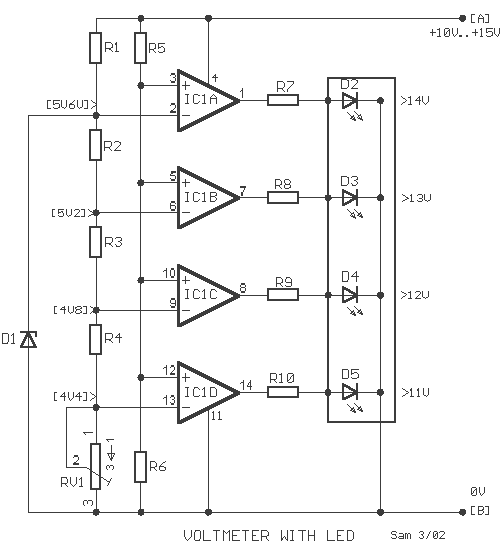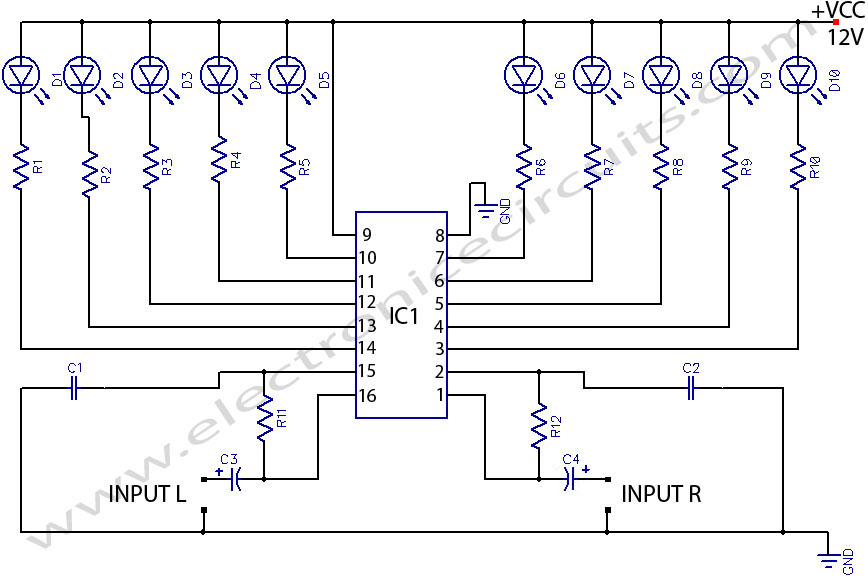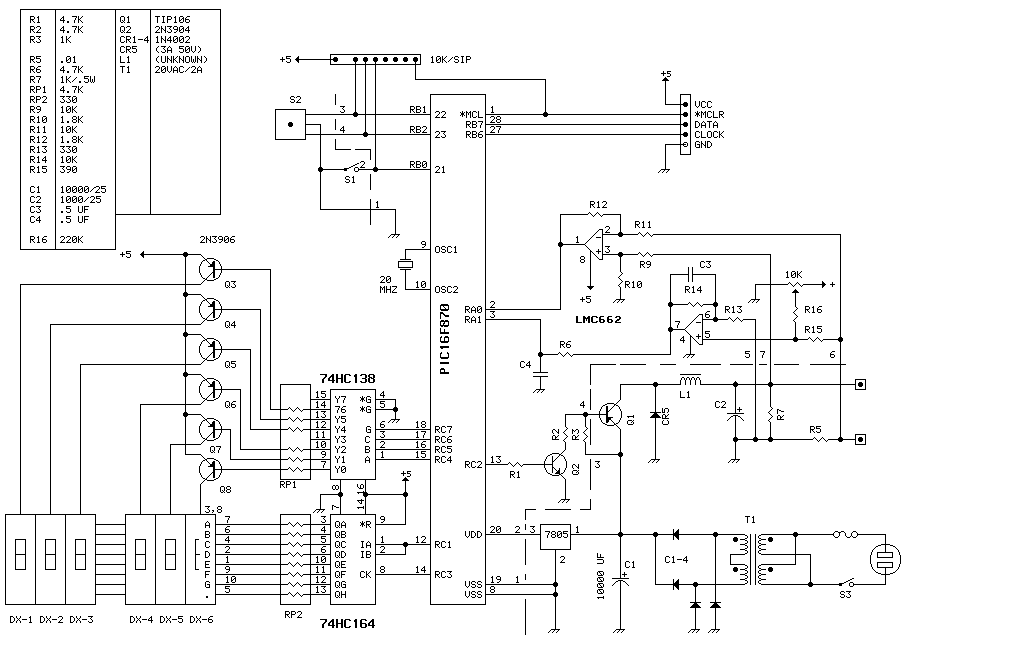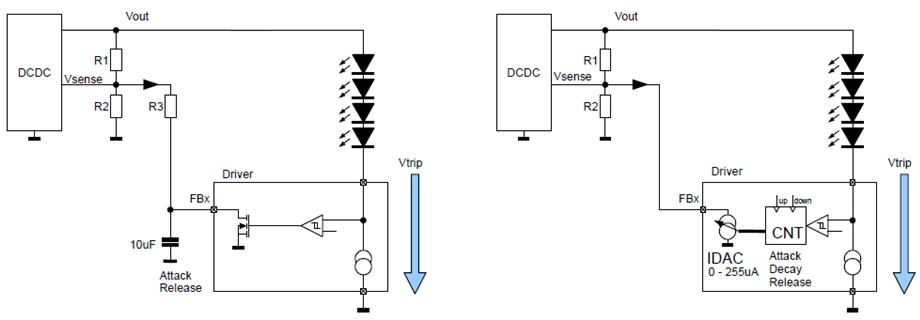
LED Voltmeter for Cars

The circuit is a comparator that can measure the voltage of a car battery in steps of 1 Volt. The voltage is determined after comparing the voltage of the battery, which is applied to the inverting inputs of amplifiers, with reference voltages produced by a Zener diode (D1). The Zener diode is chosen for its thermal stability. The variable resistor (RV1) is used to adjust the desired voltage level. The output indication is provided by four LEDs.
R1=1K2 R6=10K D2-3-4-5=LED R2-3-4=680R R7-8-9-10=1K IC1=LM324 R5=15K D1=5V6 /0.5W Zener RV1=10K trimmer
The described circuit functions as a voltage comparator, utilizing an LM324 integrated circuit, which contains four operational amplifiers. The primary purpose of this comparator circuit is to monitor the voltage level of a car battery, providing visual feedback through the use of LEDs that indicate the battery's voltage status.
The Zener diode (D1), specified as 5.6V with a maximum power rating of 0.5W, serves as a stable reference voltage source. This stability is crucial for accurate voltage comparisons, especially in automotive applications where temperature variations can affect performance. The reference voltage generated by the Zener diode is applied to the non-inverting input of the operational amplifier, while the battery voltage is fed into the inverting input.
Resistors R1 (1.2 kΩ), R2, R3, and R4 (all 680 Ω) are configured to set the gain of the operational amplifier and to ensure that the output is appropriately scaled for the LEDs. The variable resistor (RV1) at 10 kΩ allows for fine-tuning of the reference voltage, enabling the user to calibrate the circuit for different battery types or conditions.
The output from the LM324 is connected to four LEDs (D2, D3, D4, D5), which provide a visual indication of the battery voltage level. Each LED corresponds to a specific voltage range, illuminating sequentially as the battery voltage increases. Resistors R6 (10 kΩ) and R7 to R10 (all 1 kΩ) are used to limit the current through the LEDs, ensuring they operate within safe limits and prolonging their lifespan.
Overall, this circuit effectively combines precision voltage measurement with a user-friendly visual output, making it a practical solution for monitoring automotive battery health.The circuit, is a comparator, can measure with step of 1Volt, the voltage of battery of car. The clue of voltage become after comparison of voltage of battery, that is applied in the inverting inputs of amplifiers, with voltages of reference that are produced by a Zener D1, the value of which is such so that it present good thermic stability. With the RV1, we regulate the gradation of voltage that we want. The optical clue become from four Led. R1=1K2 R6=10K D2-3-4-5=LED R2-3-4=680R R7-8-9-10=1K IC1=LM324 R5=15K D1=5V6 /0.5W Zener RV1=10K trimmer 🔗 External reference
R1=1K2 R6=10K D2-3-4-5=LED R2-3-4=680R R7-8-9-10=1K IC1=LM324 R5=15K D1=5V6 /0.5W Zener RV1=10K trimmer
The described circuit functions as a voltage comparator, utilizing an LM324 integrated circuit, which contains four operational amplifiers. The primary purpose of this comparator circuit is to monitor the voltage level of a car battery, providing visual feedback through the use of LEDs that indicate the battery's voltage status.
The Zener diode (D1), specified as 5.6V with a maximum power rating of 0.5W, serves as a stable reference voltage source. This stability is crucial for accurate voltage comparisons, especially in automotive applications where temperature variations can affect performance. The reference voltage generated by the Zener diode is applied to the non-inverting input of the operational amplifier, while the battery voltage is fed into the inverting input.
Resistors R1 (1.2 kΩ), R2, R3, and R4 (all 680 Ω) are configured to set the gain of the operational amplifier and to ensure that the output is appropriately scaled for the LEDs. The variable resistor (RV1) at 10 kΩ allows for fine-tuning of the reference voltage, enabling the user to calibrate the circuit for different battery types or conditions.
The output from the LM324 is connected to four LEDs (D2, D3, D4, D5), which provide a visual indication of the battery voltage level. Each LED corresponds to a specific voltage range, illuminating sequentially as the battery voltage increases. Resistors R6 (10 kΩ) and R7 to R10 (all 1 kΩ) are used to limit the current through the LEDs, ensuring they operate within safe limits and prolonging their lifespan.
Overall, this circuit effectively combines precision voltage measurement with a user-friendly visual output, making it a practical solution for monitoring automotive battery health.The circuit, is a comparator, can measure with step of 1Volt, the voltage of battery of car. The clue of voltage become after comparison of voltage of battery, that is applied in the inverting inputs of amplifiers, with voltages of reference that are produced by a Zener D1, the value of which is such so that it present good thermic stability. With the RV1, we regulate the gradation of voltage that we want. The optical clue become from four Led. R1=1K2 R6=10K D2-3-4-5=LED R2-3-4=680R R7-8-9-10=1K IC1=LM324 R5=15K D1=5V6 /0.5W Zener RV1=10K trimmer 🔗 External reference





